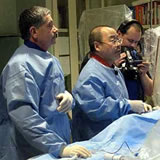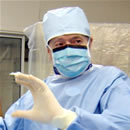|
Interest in Transradial
Angioplasty Growing
Among U.S. Cardiologists
Patients Prefer the
Wrist Technique for Stents or Angioplasty;
Training of Cardiologists
is a Key Issue
|
 |
June 10, 2008, New York --
In many countries around the world, angioplasty or stenting is done
through an artery in the wrist 30-50% of the time. A recent study
reported half the bleeding complications and lower mortality
with this method. Additionally, patients are able to sit up and
walk almost immediately after the procedure -- eliminating the hours
of
manual
compression
and lying flat on their backs.
Yet in the United States, the use
of this
technique,
called transradial angioplasty,
remains in
the
low
single
digits. One of the reasons has to do with the training of interventional
cardiologists.

Kirk Garratt,
MD, MSc. |
|
According
to Dr. Kirk Garratt, Director of Clinical Research at Lenox
Hill Heart and Vascular Institute of New York:
"Despite the benefits of transradial access, most fellowship
training programs continue to train clinical and interventional
cardiologists using a transfemoral technique. That perpetuates
the practice.
"Here at Lenox Hill, we make special efforts to train
our fellows in competency with the radial approach. Half
of the fellows we graduate end up using radial access as
their preferred access route, if for no other reason than
to capture that differentiator in a competitive marketplace."
|
For
those cardiologists who have not trained at a center where
radial access is practiced,
an alternative is to attend a live demonstration course, such
as the one being held this week at St. Vincent's Hospital in
Manhattan by Drs. John Coppola and Tak Kwan. Joining the St.
Vincent's cardiologists will be Dr. Shigeru Saito of Kamakura,
Japan, one of the world's leading practitioners of transradial
intervention (read
our exclusive interview with Dr. Saito).
During two-days,
cardiologists will receive hands-on training, covering the
clinical, didactic and practical aspects of Transradial Access.
The course,
one of several held around the country, was already fully subscribed
two weeks in advance, showing increased interest by cardiologists
wishing to offer their patients the advantages of radial access. |
|

Drs. Coppola
and Saito during
transradial case at
St. Vincent's |

John
T. Coppola, MD
|
|
One of the main reasons why Dr.
Coppola of St. Vincent's uses the transradial approach, whenever
possible, is safety. As Dr. Coppola tells Angioplasty.Org:
"For the patients, the benefit
is that it's a safer procedure. There's a lack of bleeding.
And everything that's coming
out now in the literature suggests that if you have bleeding
complications, it impacts not only on your short-term, but
your long-term survival.... [For the cardiologist,] having
that benefit in terms of less bleeding makes you more willing
to use potent antiplatelet agents, like IIb/IIIa inhibitors...because
you're not worrying about retroperitoneal bleeds or groin
hematomas."
|
To assist in educating the professional and patient
population in the U.S. about the this technique,
Angioplasty.Org has created the "Radial
Access Center for Transradial Approach", a special section
devoted to information and news about the transradial technique,
for both
patients and physicians. The Radial Center features interviews
with leading practitioners of the radial technique, such as Drs.
Jeffrey
Popma, R. Lee Jobe, John Coppola, Shigeru Saito, Kirk Garratt and Howard
Cohen.
For patients there is also a "Hospital
Locator" that lists U.S. centers practicing radial angiography.
As Dr. Howard Cohen, also of Lenox Hill Hospital,
says of the wrist technique, "Patients really prefer it. 95%
of people who've had it both ways would say 'I'm coming back to
you, Dr. Cohen
because
I like this transradial a lot better than the other way!'
Reported by Burt Cohen, June 10, 2008
|



